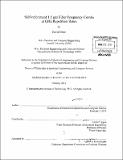Self-referenced 1.5 [mu]m fiber frequency combs at GHz repetition rates
Author(s)
Chao, David, Ph. D. Massachusetts Institute of Technology
DownloadFull printable version (20.95Mb)
Other Contributors
Massachusetts Institute of Technology. Dept. of Electrical Engineering and Computer Science.
Advisor
Erich P. Ippen.
Terms of use
Metadata
Show full item recordAbstract
Tremendous advances in recent years to the optical frequency comb, particularly frequency combs deriving from solid-state and fiber architectures, have enabled a host of important new applications to emerge - applications which include optical arbitrary waveform generation (OAWG), high-speed photonic analog-to-digital conversion (EPIC), space exploration (Astro- Comb) as well as precision spectroscopy and optical clocks. Fiber-based frequency combs have increasingly become attractive alternatives to solid-state systems due to their compact size and robust operation and have recently demonstrated performance comparable to their more traditional counterparts. One area for improvement, however, is in the repetition rate of such systems, as fiber frequency combs based on Ytterbium (Yb) and Erbium (Er) technologies currently only operate with repetition rates =/< 1GHz and =/< 300MHz, respectively, while solid-state frequency combs have been demonstrated up to 10GHz. This thesis reports on the development of a 1 GHz repetition rate Erbium-doped fiber laser frequency comb and discusses its potential to be scaled to even higher repetition rates. Nanojoule femtosecond pulses are produced at a GHz repetition rate and used to generate over an octave of supercontinuum spanning 1 [mu]m -2.4 [mu]m. Carrier-envelope offset frequency (fceo) detection using f-2f self-referencing provides confirmation that the continuum's frequency comb structure remains intact after undergoing amplification, compression, and supercontinuum generation. The fceo beat, along with the laser repetition rate frep, are locked to stable microwave reference oscillators, yielding, to the best of our knowledge, the first octave-spanning self-referenced optical frequency comb centered at the 1.5 [mu]m telecom band generated at or above a GHz repetition rate.
Description
Thesis (Ph. D.)--Massachusetts Institute of Technology, Dept. of Electrical Engineering and Computer Science, 2012. In title on title-age, "[mu]" appears as the lower case Greek letter. Page 142 blank. Cataloged from PDF version of thesis. Includes bibliographical references (p. 133-141).
Date issued
2012Department
Massachusetts Institute of Technology. Department of Electrical Engineering and Computer SciencePublisher
Massachusetts Institute of Technology
Keywords
Electrical Engineering and Computer Science.